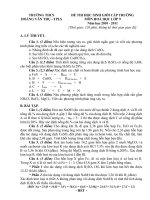trường thcs hoàng xuân hãn
Bạn đang xem bản rút gọn của tài liệu. Xem và tải ngay bản đầy đủ của tài liệu tại đây (92.37 KB, 2 trang )
<span class='text_page_counter'>(1)</span><div class='page_container' data-page=1>
14th Bay Area Mathematical Olympiad
BAMO-12 Exam
February 28, 2012
The time limit for this exam is 4 hours. Your solutions should be clearly written arguments. Merely stating
an answer without any justification will receive little credit. Conversely, a good argument which has a few minor
errors may receive substantial credit.
Please label all pages that you submit for grading with your identification number in the upper-right hand
corner, and the problem number in the upper-left hand corner. Write neatly. If your paper cannot be read, it
cannot be graded! Please write only on one side of each sheet of paper. If your solution to a problem is more than
one page long, please staple the pages together.
The five problems below are arranged in roughly increasing order of difficulty. Few, if any, students will
solve all the problems; indeed, solving one problem completely is a fine achievement. We hope that you enjoy
the experience of thinking deeply about mathematics for a few hours, that you find the exam problems interesting,
and that you continue to think about them after the exam is over. Good luck!
Problems
1 Answer the following two questions and justify your answers:
(a) What is the last digit of the sum 12012+22012+32012+42012+52012 ?
(b) What is the last digit of the sum 12012+22012+32012+42012+· · ·+20112012+20122012 ?
2 Two infinite rows of evenly-spaced dots are aligned as in the figure below. Arrows point from every dot in the top
row to some dot in the lower row in such a way that:
• No two arrows point at the same dot.
• No arrow can extend right or left by more than 1006 positions.
Show that at most 2012 dots in the lower row could have no arrow pointing to them.
</div>
<span class='text_page_counter'>(2)</span><div class='page_container' data-page=2>
2
3 Letx1,x2, . . . ,xkbe a sequence of integers. A rearrangement of this sequence (the numbers in the sequence listed
in some other order) is called ascrambleif no number in the new sequence is equal to the number originally in
its location. For example, if the original sequence is 1,3,3,5 then 3,5,1,3 is a scramble, but 3,3,1,5 is not.
A rearrangement is called atwo-twoif exactly two of the numbers in the new sequence are each exactly two more
than the numbers that originally occupied those locations. For example, 3,5,1,3 is a two-two of the sequence
1,3,3,5 (the first two values 3 and 5 of the new sequence are exactly two more than their original values 1 and 3).
Letn≥2. Prove that the number of scrambles of
1,1,2,3, . . . ,n−1,n
is equal to the number of two-twos of
1,2,3, . . . ,n,n+1 .
(Notice that both sequences haven+1 numbers, but the first one contains two 1s.)
4 Given a segmentABin the plane, choose on it a pointMdifferent fromAandB. Two equilateral triangles4AMC
and4BMDin the plane are constructed on the same side of segmentAB. The circumcircles of the two triangles
intersect in pointMand another pointN. (Thecircumcircleof a triangle is the circle that passes through all three
of its vertices.)
(a) Prove that linesADandBCpass through pointN.
(b) Prove that no matter where one chooses the pointMalong segmentAB, all linesMNwill pass through some
fixed pointKin the plane.
5 Find all nonzero polynomialsP(x)with integer coefficients that satisfy the following property: wheneveraandb
are relatively prime integers, thenP(a)andP(b)are relatively prime as well. Prove that your answer is correct.
(Two integers arerelatively primeif they have no common prime factors. For example, -70 and 99 are relatively
prime, while -70 and 15 are not relatively prime.)
You may keep this exam. Please remember your ID number! Our grading records will
use it instead of your name.
You are cordially invited to attend theBAMO 2012 Awards Ceremony, which will be
held at the Mathematical Sciences Research Institute, from 11–2 on Sunday, March 11.
This event will include lunch, a mathematical talk, and the awarding of dozens of prizes.
Solutions to the problems above will also be available at this event. Please check with your
proctor for a more detailed schedule, plus directions.
</div>
<!--links-->









